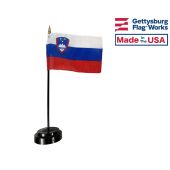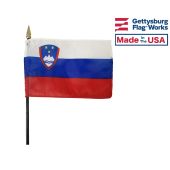Buy Slovenia Flags
Flag of Slovenia
The story of the Slovenia flag is similar to that of other Slavic flags. Some elements of the design can be traced back to the medieval period, while the design itself was first used to represent the nation during the middle of the 19th century. The changes that Slovenia flags have experienced over the years are similar to the changes that the nation has experienced, which has ensured that they are excellent symbols of the nation and its people.
- Capital of Slovenia: Ljubljana
- Area of Slovenia: 20,151 sq. km
- Languages used in Slovenia: Slovenian, Serbo-Croatian
- Religions in Slovenia: Catholic, Orthodox, other Christian, Muslim
Colors and Symbolism of Slovenia Flags
Slovenia flags have three horizontal bands of white, blue, and red. The flag also displays the national coat of arms in the canton. The coat of arms features a white image of Mount Triglav rising up from two blue lines with a trio of stars above it. Each element of the coat of arms represents an aspect of the nation's heritage. The mountain is the highest peak in the country, while the blue lines beneath it represent the waterways that have had a major impact on the nation's history. The stars come from a medieval coat of arms that once represented a major dynasty within the nation, which makes it a potent symbol of the country's history.
The flag's colors are the Pan-Slavic colors, which makes them an expression of solidarity with other Slavic nations. They also originated among the heraldry of local nobles, so they represent the shared history of the Slavic people.
History of the Slovenia Flag
The modern Slovenia flag dates back to 1848, when nationalist revolutionaries used it to represent their movement and their country. The flag came to be a symbol of the Slovenian nation and people even though the initial movement failed to achieve its goals, and some form of it has represented the nation ever since. The flag was even carried by partisans during the second world war when they fought against invading armies.
A variant on the flag that included a red star represented Yugoslavia, which included Slovenia, from 1945 to 1992. The star represented the government's communist ideals, and it was removed from the flag when Slovenia gained its independence and abandoned that ideology. The new flag has represented the country ever since. There have been efforts to update the flag to distinguish it from that of other nations, but the design remains popular with the people and so it has not yet been altered.






